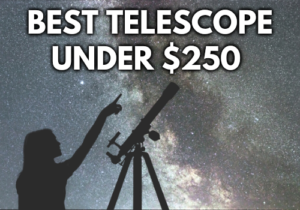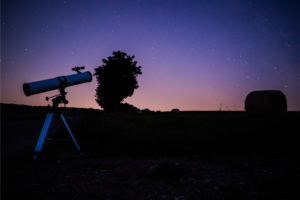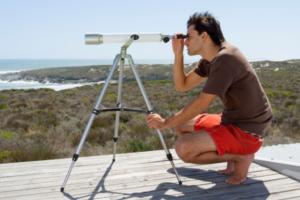9 Best Telescope Finder Scopes of 2025; Reviews
Disclosure: This post contains affiliate links and I may earn a small commission (at no extra cost to you) if you click through and make a purchase. Thanks in advance – I really appreciate it!
The best telescope finderscope for you is the one that provides a wide field of view to help you locate celestial objects before observing them through your main telescope.
A finderscope is one of the most important telescope accessories you can buy, and it comes in a variety of styles. But, whichever the style may be, a best telescope finder scope will help you locate and center objects more easily in the vastness of the night sky.
What is a Finderscope?
A finderscope is a small wide-field telescope mounted on a larger telescope that helps an observer quickly aim at terrestrial or celestial objects.
Because of their light-gathering capacity, finder scopes are especially useful for finding faint celestial objects that cannot be seen with the unaided eye using non-magnifying finders such as a Telrad or red dot finder.
Many telescopes come only with a non-magnifying finder, while others come with a simple low-cost, low-aperture finder scope that gives dim, inverted views that make it difficult to use.
Best Telescope Finder Scopes
Comparison Table
| Image | Title | Price | Buy |
|---|---|---|---|
 | Celestron 51635 StarPointer Pro Finderscope | See on Amazon | |
 | StarPointer Finderscope | See on Amazon | |
 | Telrad Finder Sight | See on Amazon | |
 | Celestron Illuminated RACI Finder Scope | See on Amazon | |
 | Orion 7023 9x50 Illuminated Finder Scope with Bracket | See on Amazon | |
 | SVBONY Finder Scope 5x24 with Bracket Plastic Accessory Kit | See on Amazon | |
 | Astromania 9x50 Angled Finder Scope | See on Amazon | |
 | Talcope Brightness Red Dot Finderscope | See on Amazon | |
 | SVBONY SV182 Finderscope | See on Amazon |
Product prices and availability are accurate as of the date/time indicated and are subject to change. Any price and availability information displayed on [relevant Amazon Site(s), as applicable] at the time of purchase will apply to the purchase of this product.
Prices pulled from the Amazon Product Advertising API on:Best Telescope Finder Scopes - Reviews
1. Celestron 51635 StarPointer Pro Finderscope
- Designed by astronomers for astronomers, this premium finderscope allows you to precisely zero in on your target
- Projects a dual-circle reticle, not a red dot that can obscure your subject
- Larger 40 mm optical window offers a wider field of view so you can acquire targets quickly and easily
- Brighter LED for easy visibility during the day
- Easy dovetail connection; no tools required
Prices pulled from the Amazon Product Advertising API on:
Product prices and availability are accurate as of the date/time indicated and are subject to change. Any price and availability information displayed on [relevant Amazon Site(s), as applicable] at the time of purchase will apply to the purchase of this product.
The Celestron StarPointer Pro is a premium finderscope that allows you to precisely zero in on your target (sky object).
The finder scope makes aligning the telescope easy as it projects a dual-circle reticle and not a red dot that can obscure your target.
It features a large 40 mm optical window that offers a wider field of view so you can acquire targets quickly and easily.
It has a brighter LED light that aids in easy visibility during the day and to mount it easily on a telescope without using any tools, it comes with an easy-to-connect dovetail connection.
It has a rheostat to control the reticle brightness and attaches quickly to most telescopes with a dovetail connection and finger knobs.
The StarPointer Pro was designed for astronomers by astronomers to provide you with the best experience when locating celestial objects in the night sky.
Whether you’re new to the hobby or a seasoned amateur astronomer, you’ll appreciate StarPointer Pro’s thoughtful design features.
2. Celestron StarPointer Finderscope
- The Star Pointer Finder scope adds “point & look” functionality to any telescope
- This red dot finder keeps the sky right-side up, matching what you see with your unaided eyes
- The adjustable red dot is bright enough to see day or night
- Attaches to just about any telescope thanks to the small footprint, even works great with astronomical binoculars and spotting scopes
- Includes mounting base and a long-lasting CR2032 3V battery
Prices pulled from the Amazon Product Advertising API on:
Product prices and availability are accurate as of the date/time indicated and are subject to change. Any price and availability information displayed on [relevant Amazon Site(s), as applicable] at the time of purchase will apply to the purchase of this product.
The Celestron StarPointer Finderscope has a 1x magnification, and it displays a super-wide field of view.
It also keeps the sky right side up and left-to-right correct, matching what you see with your unaided eyes.
An LED creates a red dot, superimposed on a viewing screen, so you simply point the StarPointer to the area or object you wish to observe, look through your eyepiece, and if properly aligned, the area in and around the place you pointed the red dot will be centered in the field of view.
Having this one of the best telescope finderscopes in your arsenal is almost like having a laser pointer that reaches into the sky, it greatly simplifies finding objects.
The brightness level is adjustable, and the Star Pointer can be used during daytime observing as well.
It even attaches to any telescope easily and it operates on one 3V CR2032 lithium button battery that comes included with the package.
3. Telrad Reflex Sight
- The easiest way to aim a telescope. The view seen through the window of the Telrad is continuous with the sky around it, not magnified or upside do
Prices pulled from the Amazon Product Advertising API on:
Product prices and availability are accurate as of the date/time indicated and are subject to change. Any price and availability information displayed on [relevant Amazon Site(s), as applicable] at the time of purchase will apply to the purchase of this product.
The Telrad Finder Scope provides a non-magnified window on the sky and projects 1/2 inch, 2-inch, and 4 inch illuminated red bullseye circles on the screen which can be brightened or dimmed for user needs.
Simply place the star in the center of the bullseye and start star hopping across the night sky.
The Telrad mounts to your telescope easily and cleanly with double-stick tape. Once mounted, the Telrad is easy to align and is powered by two AA batteries.
When you look through The Telrad finder you will see a large ring that projects a 0.5 degree, 2 degrees, and 4-degree bull’s eye.
In virtually all instances when you look through the Telrad it appears as though the multi-degree bull’s eye is actually projecting onto the night sky which makes it very easy to hunt for your favorite night sky objects.
The Telrad is 8.15″ long and 2.24″ wide (at the base) so please make sure that you have sufficient clear area on your telescope tube to mount this as this could be a challenge on very short OTAs.
This one of the best telescope finderscopes weighs a mere 11 ounces due to its lightweight yet robust ABS plastic construction.
4. Celestron Illuminated RACI Finder Scope
- Upgrade your finder and stop straining your neck and back!
- This well-built 9x50 finder displays right side up, left-to-right correct views, a great choice for both daytime and nighttime use
- Illuminated double-crosshair reticle doesn’t hide stars
- Includes double ring bracket with integrated dovet
Prices pulled from the Amazon Product Advertising API on:
Product prices and availability are accurate as of the date/time indicated and are subject to change. Any price and availability information displayed on [relevant Amazon Site(s), as applicable] at the time of purchase will apply to the purchase of this product.
The Celestron 9×50 Right Angle Correct Image (RACI) Illuminated Finder is a great upgrade to the stock finderscopes found on most Celestron Schmidt-Cassegrain telescopes.
The 50 mm optics produce bright, sharp images with a magnification of 9x and a 5º apparent field of view.
Meanwhile, the right-angle, correct-image design keeps objects right-side up and left-to-right correct, making it easier to locate objects as well as track them as they drift through the field of view.
The eyepiece module can be rotated left or right so you can find the perfect viewing angle.
The double-crosshair reticle etched in the eyepiece makes it easy to center an object, whether you are aligning your computerized telescope or finding deep-sky objects on your own.
The reticle can be focused separate from the finder itself. A battery-powered illuminator lights up the crosshair with a soft, red glow, and the illumination can be easily adjusted by turning the on/off knob.
Its right-angle orientation reveals a corrected image so you can quickly locate your target object when it is directly overhead, so you don’t need to strain your neck while aligning.
5. Orion 7023 9x50 Illuminated Finder Scope
- Big 50mm aperture, 9x finder scope with illuminated double crosshairs makes it easy to aim your telescope with precision at night, without compromising your dark-adapted vision
- Contains an adjustable-intensity red LED in the illuminator arm that lights an etched-glass double crosshair reticle
- Features multi-coated achromatic optics, adjustable focus, 13mm eye relief and a fold-down rubber eyeguard for comfortable use
- 4.5 field of view finder scope includes aluminum dovetail mounting bracket with spring-loaded X-Y adjustment screws for quick and easy alignment
- Requires three SR-54 batteries for illuminator operation, inclu
Prices pulled from the Amazon Product Advertising API on:
Product prices and availability are accurate as of the date/time indicated and are subject to change. Any price and availability information displayed on [relevant Amazon Site(s), as applicable] at the time of purchase will apply to the purchase of this product.
The Orion 7023 finderscope has a large 50mm aperture, and it features illuminated double crosshairs that make it easy to aim your telescope with precision at night, without compromising your dark-adapted vision.
An adjustable-intensity red LED in the illuminator arm lights an etched-glass double crosshair reticle, making it as easy as target practice to center your viewing or photo subject or guide star.
It also features multi-coated achromatic optics, adjustable focus, 13mm eye relief, and a fold-down rubber eye-guard for comfortable use.
The finderscope also comes with an aluminum dovetail mounting bracket with spring-loaded X-Y adjustment screws for quick and easy alignment.
6. SVBONY Finder Scope 5x24
- Mounting bracket has curved base with two holes and attaches to telescope tube with bolts or screws;bracket will not slide into a dovetail base
- Wth it you are more convenient to find the s
Prices pulled from the Amazon Product Advertising API on:
Product prices and availability are accurate as of the date/time indicated and are subject to change. Any price and availability information displayed on [relevant Amazon Site(s), as applicable] at the time of purchase will apply to the purchase of this product.
This SVBONY finder scope is a secondary scope that’s used to help you locate objects in the main telescope.
It has 3 thumb screws that allow positioning XY adjustment for precise telescope alignment.
It provides 5×24 low power magnification.
The finderscope should be fixed to the body of a more powerful telescope and pointed in the same direction for initially locating an object to be observed
The optical tube has a glossy black metallic finish and a crosshair reticle.
The finderscope comes with mounting brackets and dust caps, and the bracket fits any telescope and the included dust caps protect against dust and fingerprints.
7. Astromania 9x50 Angled Finder Scope
- 9x50 finder scope with 50mm objective lens diameter, brighter DSOs directly visible.
- Makes a large number of aditional stars available - a big plus for being able to successfully locate objects.
- The 90° viewing angle makes your searching much more easy and comfortable, even near the zenith.
- The achromatic optics provide a bright, true-to-life image at 9x magnification. In addition, the optical surfaces have been multi-coated to prevent irritating reflections.
- Finder fits onto most telescopes, easy focusing at the objective lens. Adjustment of finder scope alignment via two screws and spri
Prices pulled from the Amazon Product Advertising API on:
Product prices and availability are accurate as of the date/time indicated and are subject to change. Any price and availability information displayed on [relevant Amazon Site(s), as applicable] at the time of purchase will apply to the purchase of this product.
This finder scope has a 50mm aperture, and so it provides a particularly bright image. Objects which you are not even able to see using just the naked eye will usually become directly visible.
Also, if you are trying to locate one of the brighter DSOs, this will no longer be able to remain hidden, giving itself up to your searching eye.
After you attach this scope to your telescope tube, you can use its low-level magnification to track whatever you’re looking for.
The unit looks like your average straight-through scope. But, it’s equipped with some advanced features.
The first is the red LED light. It illuminated the reticles and is less obtrusive than pure white LED lights. It’s also dimmable, which is a nice touch.
The Astromania finder scope has a wide field of view to make locating objects easier.
With this finderscope, you can enjoy both a comfortable 90° viewing angle and an upright, non-reversed image.
An integrated prism displays objects in a similar way to that with binoculars or spotting scopes.
8. Talcope Brightness Red Dot Finderscope
- Simple to Install: Red dot sighting device aiming your telescope is effective. Adjustment knobs work well, you evened up the finder with the adjustment knobs before you put it on your telescope. It was a breeze dialing it in.
- Quality Assurance: Comes with a one-year after-sales guarante
Prices pulled from the Amazon Product Advertising API on:
Product prices and availability are accurate as of the date/time indicated and are subject to change. Any price and availability information displayed on [relevant Amazon Site(s), as applicable] at the time of purchase will apply to the purchase of this product.
This finderscope red dot sight comes with an adjustable LED dot that is projected onto a non-magnifying viewing window. It’s easy to find the red dot because it contrasts well with the color of the lens material. So you can aim the main telescope quickly and easily.
The star pointer brightness of the red dot is adjustable to different environments. It is bright enough to use during the day or night.
It comes with a bracket that fits the dovetail mounting base of almost all the telescopes.
It also comes with a long-lasting CR2032 3V battery to ensure long stargazing sessions.
The finderscope is beginner-friendly and it’s very easy to set up and use.
9. SVBONY SV182 Finder Scope
- Improve the light gathering capabilities; 30mm wide aperture; has a strong light gathering capability; allowing you to see faint objects in the sky
- Appropriate focal length; 120mm focal length; which is ideal for your observation; a powerful 6x crosshair; reticles make lining up your target easier
- Comfortable to observe; 90-degree right angle; comfortable observation angle improves the experience of using the finder; no need to bend over or twisting your neck; improve the experience of your observation
- Get a erect image; prism steering was added to the finder optical system; meet the observation habit that people always have
- Fully multi coated lens coating; improve the light transmission; provide a clear view of the night sky; ensures a sharp and bright image; making it easy to find your target f
Prices pulled from the Amazon Product Advertising API on:
Product prices and availability are accurate as of the date/time indicated and are subject to change. Any price and availability information displayed on [relevant Amazon Site(s), as applicable] at the time of purchase will apply to the purchase of this product.
The SV182 finder scope with 6x power magnification and a 30mm diameter lens collects ample light to make aiming your telescope easy and fun.
The SV182 finder scope features a fully multi-coated Achromatic 2-Element lens design that enables the finderscope to effectively eliminate chromatic aberrations.
The finderscope is easy to use as it comes with a metal finder bracket, 2 plastic adjustment screws, a 90-degree angle, and a fixed spring push-pull screw.
You will only need to adjust 2 screws to quickly find and hone in on the target.
The inside of the SV182 finder scope’s optical tube is fully threaded to minimize reflections.
This one of the best telescope finderscopes weighs only 0.49lbs. that won’t add excessive weight or bulk to your main telescope.

How to Use a Telescope Finder Scope
Using a telescope finder scope is pretty straightforward. Make sure that you align the finderscope with your telescope during the day.
First of all, pull out the clear plastic sheet that is at the front and on the bottom. This allows the battery to make contact so that the red dot appears when you switch it on.
Next, try the finder by switching it on. Look through the hole at the front of the finder and you should see the red dot or reticle and be able to make it brighter or dimmer by using a switch or a knob on the finderscope.
Now set your scope up as normal but put the red dot finder on instead of the usual optical finder.
Point your telescope to something like a TV aerial or a chimney – anything about that size will do, and the further away the better.
Looking through a low-power eyepiece (25mm is ideal) find the object by adjusting your telescope and focusing the object.
Adjust the mount using the slow-motion controls so that the object is right in the center of the view.
Adjust the finder so that the red dot or reticle is exactly on the object you were looking at.
Switch it off and wait until dark.
You now use it by switching the finder on, then looking through the finder so that the red dot lines up to the target you are going to observe through your telescope.
Once the red dot is exactly over the star or planet it should be exactly in the center of your eyepiece view.
Remember to switch off your finderscope once you have found your target to save the battery.
Types of Telescope Finderscopes
The finderscopes mainly come in three different designs.
1. Red Dot Finder
The Red Dot Finderscopes are simple and easy-to-use and they generally come with zero magnification view of the sky that is right-side up and left-to-right correct.
Some red dot finders project shapes other than a red dot, like a bull’s eye or a crosshair. Other models let you choose from a collection of illuminated reticles or dots.
2. Right Angle Finder
A right-angle finder scope has an eyepiece that faces up. This makes it easier to look through, especially when the telescope is pointing high overhead. Many right-angle finder scopes are “image erect” or “image correct” as well, which means the image you see will be right side up and/or left-to-right correct.
So if you wish to avoid a stiff neck and painful contortions when looking through a straight-through finder, a right-angle finder scope is the solution.
These scopes use a small prism diagonal to direct the light upward into the eyepiece at a right angle to the finder tube.
Right-angle finders can be used with most telescopes, but they tend to be especially easy to use with Newtonian reflectors when they are placed in proximity to the telescope’s focuser.
3. Straight-Through Finderscopes
A straight-through finder puts the eyepiece at the back facing out. These finderscopes look like miniature telescopes. You look straight through the eyepiece and down the optical axis to achieve magnification. Straight-through models are best for refractors or Schmidt-Cassegrain telescopes.
Conclusion
I hope this article has helped you sort out and compare different models to pick out the best telescope finderscope for yourself. These devices work by showing more of the night sky than your telescope does, but they work by centering on exactly the same piece of sky. With the information in this guide, you will be ready to make the right choice for your telescope and observing interests.
Written by:

Prakash Chandra
I am a science and technology enthusiast who is curious about emerging concepts in spaceflight, aerospace, and robotics. My passion for astronomy started in my childhood, and my craze for writing started when my works got published in my school's newspaper.
ABOUT US
We are a team of active amateur astronomers, here to help you with all your astronomy and science related needs – this is anything, from reviewing the latest telescopes to be released to talking about gravity and neurons. The Big Bang Optics was started because of our love for astronomy and to help others like us find the best telescope and accessories.
LEGAL DISCLAIMER
The Big Bang Optics is a participant in the Amazon Services LLC Associates Program, an affiliate advertising program designed to provide a means for sites to earn advertising fees by advertising and linking to Amazon.com. The Big Bang Optics also participates in affiliate programs with Clickbank and other sites. The Big Bang Optics is compensated for referring traffic and business to these companies.













